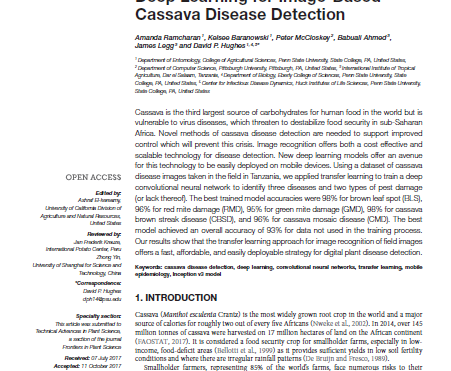Cassava is the third largest source of carbohydrates for human food in the world but is vulnerable to virus diseases, which threaten to destabilise food security in sub-Saharan Africa. Novel methods of cassava disease detection are needed to support improved control which will prevent this crisis. Image recognition offers both a cost effective and scalable technology for disease detection. New transfer learning methods offer an avenue for this technology to be easily deployed on mobile devices. Using a data set of cassava disease images taken in the field in Tanzania, this study applied transfer learning to train a deep convolutional neural network to identify three diseases and two types of pest damage (or lack thereof). The best trained model accuracies were 98% for brown leaf spot (BLS), 96% for red mite damage (RMD), 95% for green mite damage (GMD), 98% for cassava brown streak disease (CBSD), and 96% for cassava mosaic disease (CMD). The best model achieved an overall accuracy of 93% for data not used in the training process. Our results show that the transfer learning approach for image recognition of field images offers a fast, affordable and easily deployable strategy for digital plant disease detection.
Region: Tanzania
Date published:
2017
Published by:
Frontiers in Plant Science
Type of resource:
Journal article
Resource topic:
Cassava
Project/Programme: Not specific
Pest/Disease: Brown leaf spot, Cassava brown streak virus, Cassava mosaic virus, Green mite damage, Red mite damage
Pages:
7
File type:
External link (2.2 MB)




